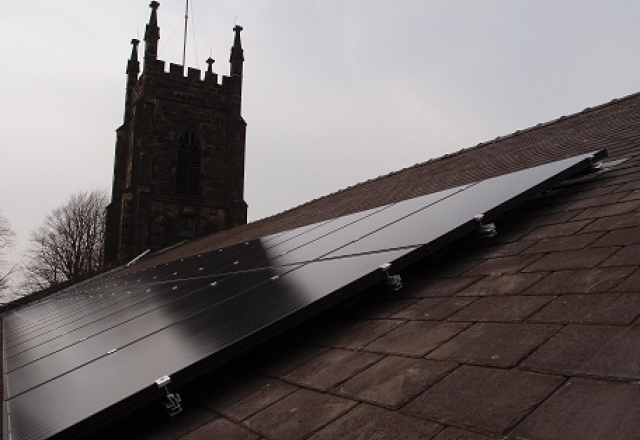A CHURCH built to celebrate the British victory at the Battle of Waterloo is now generating its own power thanks to solar panels.
St Andrew’s Church was built in the 1830s as one of the famous Waterloo Churches – built using money granted by the Government to mark the defeat of Napoleon.
The iron used in the construction of the Chancel screen in the church at Netherton, near Dudley, was made by the same company that supplied the anchor for the Titanic.
Now the church is marking its place in history once again by becoming the first in the Diocese of Worcester to install solar panels.
The system will save a staggering 5 tonnes of CO2 a year – in three years it will have saved the equivalent weight to the anchor itself.
The 9.8kWp system was installed by Lincolnshire-based company Freewatt before the March change in Feed in Tariff.
In its first five weeks of operation the 40 panels have already generated 1,000 KWs of electricity – well ahead of its original target.
Vicar, the Rev Stephen Carter, said he was keen to use new technology to meet the commitment of the Church of England to reduce the church’s negative impact on the environment.
But he said the project also made sound financial sense. The investment is due to pay for itself in ten years and the church can then benefit from the Feed in Tariff and lower fuel costs for another 15 years.
“We wanted to do our bit towards reducing the use of fossil fuels and we had some funds available so we decided to investigate solar panels,” said Mr Carter.
“Now we have them installed we are delighted with the result. St Andrew’s already had a rich history and it’s nice to think we’ve added our own chapter to it.”
Freewatt was chosen as the preferred installer because of its track record of working with historic and listed buildings.
It was the first company to install solar panels on a church in the UK when it completed a solar scheme at St Denys’ Church in Sleaford, Lincolnshire.
Freewatt also recently completed a large project at Winchester College where it handled installations on some of the UK’s most historic buildings.
Julian Patrick, MD of Freewatt, said: “Working on sensitive buildings can pose tough challenges that we are experienced at overcoming. We frequently work with and help to coordinate local councils, diocesan committees, parish councils, English Heritage and grant funding bodies.
“Freewatt have developed unique mounting systems for the installation of solar PV systems specifically on ancient buildings. The sympathetic nature of the fixings has gained the approval of English Heritage on several sites across the country.
“Working on these ancient buildings carries a great responsibility that we embrace. It is very rewarding to be working on such fine buildings and doing our bit to make sure they are sustainable in the future.”
11 AprChurch with link to Titanic goes green

"Working on these ancient buildings carries a great responsibility that we embrace."

0 Responses to “Church with link to Titanic goes green”